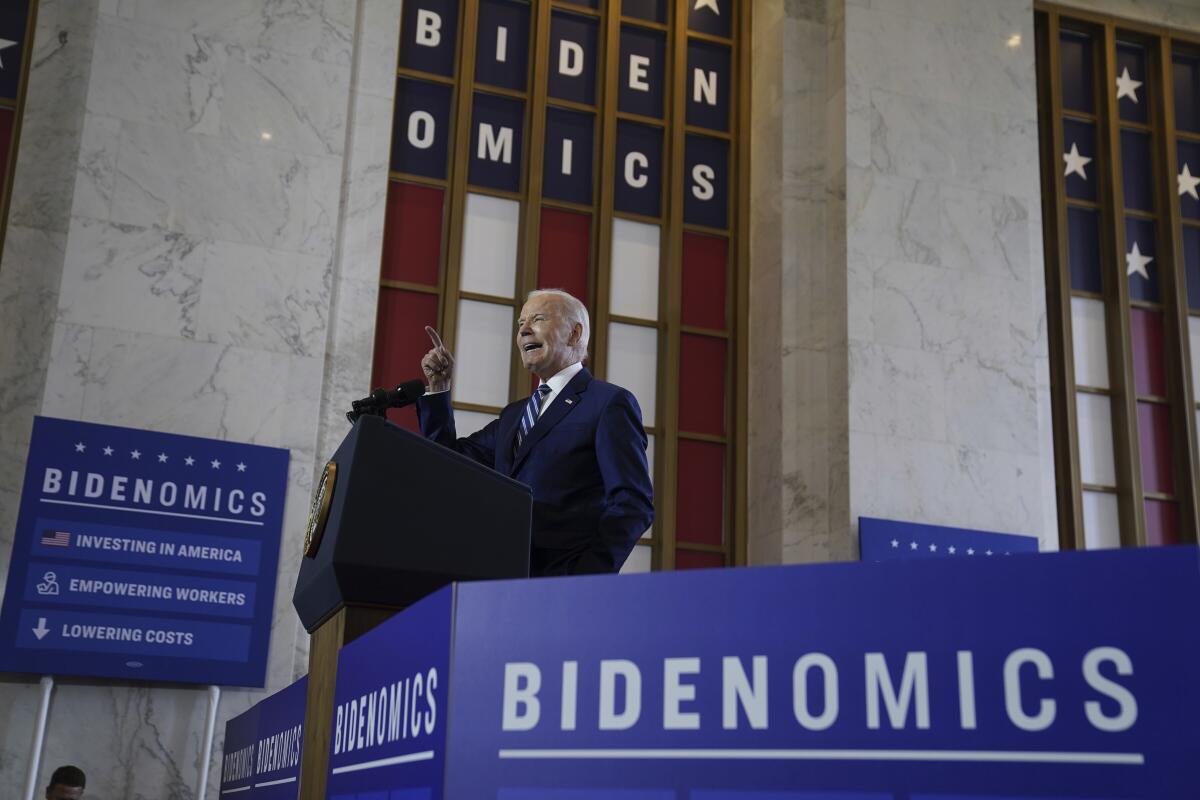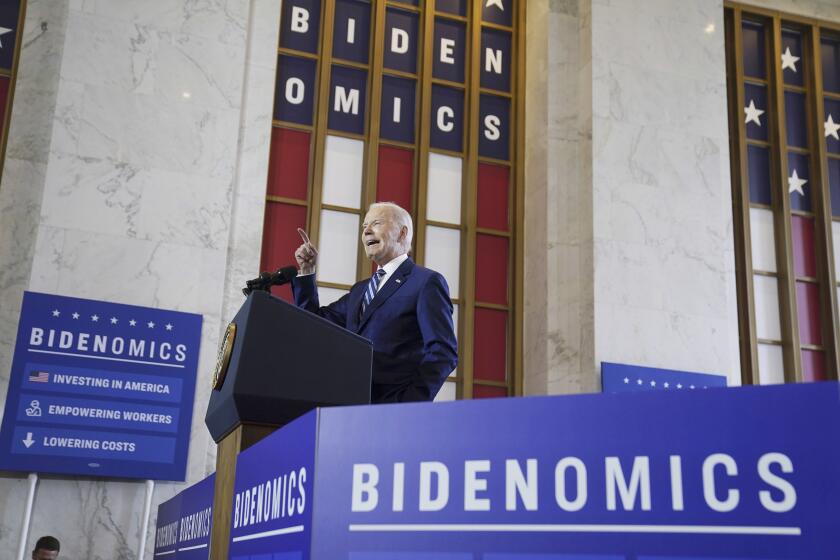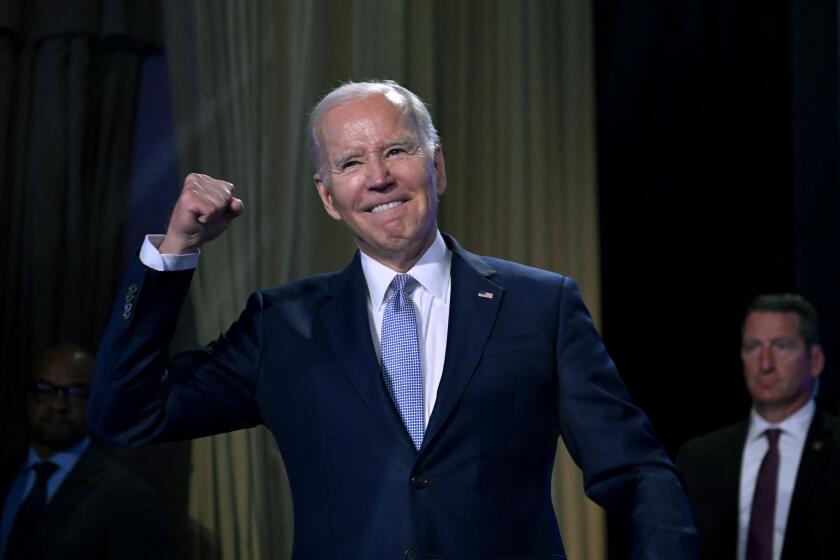So what is ‘Bidenomics’ anyway? Certainly not the key to President Biden’s reelection

- Share via
The ghost of Ronald Reagan seems to be haunting — or at least consulting — Joe Biden’s White House. The administration’s recent embrace of the term “Bidenomics,” which echoes “Reaganomics,” seeks to turn a less-than-complimentary jab from the Wall Street Journal and Financial Times into a positive talking point about Biden’s economic accomplishments.
Just before Biden delivered a major economic speech in Chicago last month, his press office announced that Bidenomics is “the word of the day, word of the week, word of the month, word of the year.” As a strategic move, however, this particular presidential coinage might not be as smart as they think it is.
Inflation is down sharply, employment is holding steady and GDP is growing. But Americans are still blaming Biden for a lousy recovery.
Let’s start with the Reagan connection. “Reaganomics” was coined in the early 1980s by the legendary conservative radio broadcaster Paul Harvey, who, unlike the wordsmiths who invented “Bidenomics,” was sympathetic to the program. Reagan’s critics called it “trickle-down economics”; during the 1980 Republican primary contest, George H.W. Bush famously called it “voodoo economics.”
Reagan’s economic policies, also known as supply-side economics, aimed to cut taxes, increase defense spending, slow the growth of non-defense government functions and reduce the deficit. Biden’s economic plan is in direct contrast: He recently described it as an alternative to “trickle-down” economics that is instead concerned with “building the economy from the middle out and the bottom up.”
Experts and partisans still debate the successes and failures of Reaganomics. Regardless, while Reagan never publicly used the words “trickle-down” or “Reaganomics,” his economic policies remain a significant part of his legacy for those who admire the man and his presidency.
Given that, it’s curious that the Biden team would rely on the most revered and iconic Republican president of the modern era for branding inspiration. Plus, presidents’ names often end up attached to their perceived failures. Think “Hoovervilles,” the term used to describe Great Depression shantytowns under Herbert Hoover; “Johnson’s War” as a critical commentary on Vietnam; or the “Bushisms” born of George W. Bush’s adventures in public speaking.
“Obamacare” also got its start as a pejorative to describe the “socialized medicine” the country would be subjected to under the Affordable Care Act. Barack Obama eventually embraced the nickname, saying in a 2014 interview with Charles Barkley that he liked the term. Ironically, polling at the time suggested that Americans liked the Affordable Care Act but not Obamacare — an example of the drawbacks of such coinages and, according to many political scientists, the pitfalls of modern polling.
What, then, is Bidenomics? The president’s June speech included some light specifics, but given that the audience for such an event is quite small, few voters are likely to have heard any of it. More recently, Biden’s team and their allies have been quick to point out that the economy is improving based on continued low unemployment and reduced inflation, suggesting Bidenomics — whatever it is — is working.
Joe Biden has an incumbent’s advantage, deep pockets and a sturdy legislative record. But, but... his age? So what?
The problem with this strategy is multifaceted. First, while any White House advisor can tout cherry-picked positive economic indicators, presidents will get blamed when the economy is bad and take credit when it’s good. Yet presidents have little if any control over the economy. If they did, we wouldn’t have downturns or inflation, which have no political upside.
Second, while inflation may be cooling, most Americans have yet to see the benefits. Many Southern Californians, for example, are likely to have a more pessimistic view of the economy given the regional cost of gas, groceries and rent. It usually takes time for voters to feel an improving economy. Case in point: The economic boom of the late 1990s was credited partly to the elder Bush’s bipartisan deal to raise taxes in 1990, but it was Bill Clinton who reaped the political benefits.
Biden’s economic plan may produce stellar results, but it’s much too early to tell. And come October, millions of people will start making student loan payments again, stretching their budgets further.
Finally, the administration’s too-clever-by-half embrace of “Bidenomics” does not advance the president’s strongest argument for a second term. Successful presidential campaigns need to tell the right story about why a candidate deserves to be elected, and this is particularly true for incumbents seeking reelection.
If we ask Reagan’s famous question during the 1980 campaign — “Are you better off now than you were four years ago?” — the answer is nuanced. Through the lens of the chaos that was and would be Donald Trump, and given the credit Biden deserves for moving the country through the pandemic, then perhaps the answer is yes.
But on so-called kitchen table economic issues, it’s a tougher sell. Recent polling suggests that only a third of Americans approve of Biden’s handling of the economy. And his overall approval rating is around 40%, with a notable lack of enthusiasm for his reelection even among Democrats.
The Bidenomics message seems to be all strategy, little substance and generally off the mark at a moment when the president desperately needs to convince the country that his leadership is better than the alternative. Asking politicians to set aside strategic and messaging gimmicks is probably too much, but the Biden team needs to give voters some credit for understanding all the issues that matter.
Lori Cox Han is a professor of political science at Chapman University and the author of several books on the American presidency.
More to Read
A cure for the common opinion
Get thought-provoking perspectives with our weekly newsletter.
You may occasionally receive promotional content from the Los Angeles Times.












